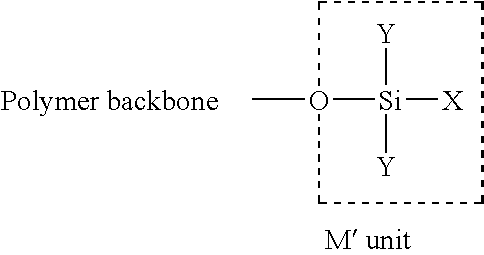Use of polysiloxanes with quaternary ammonium groups for protecting animal or human hair against heat damage
- Summary
- Abstract
- Description
- Claims
- Application Information
AI Technical Summary
Benefits of technology
Problems solved by technology
Method used
Image
Examples
example 1
Preparation of a Cationic Polysiloxane With Terminal Quaternary Functions
[0159]a) Equilibration of an SiH-functional polysiloxane[0160]16.4 g of phenyltris(dimethylsiloxy)silane, 232 g of decamethylpentasiloxane, 0.25 g of an acid catalyst were mixed in a 500 ml three-neck flask and stirred for 4 hours at 80° C. After cooling, 20 g of NaHCO3 were added and the mixture was stirred at room temperature for 12 hours. After a filtration, a clear product was obtained.[0161]b) Preparation of an epoxysiloxane[0162]300 g of the compound prepared according to 1a) and 9.3 g Allyl glycidyl ether were initially introduced together in a 500 ml three-neck flask and heated to 100° C. 15 ppm of a platinum catalyst were then added and the mixture was stirred for 2 hours. Following a subsequent reaction, a clear product with an epoxy value of 0.94% was obtained.[0163]c) Conversion to the quaternary polysiloxane polymer[0164]36 g of 3-N,N-Dimethylaminopropyllaurylamide, 11 g of lactic acid and 100 g of...
example 2
Preparation of a Linear Cationic Polysiloxane With Two Terminal Quaternary Functions
[0166]a) Equilibration of an SiH-functional polysiloxane (α,ωN=60)[0167]10 g of 1,1,3,3-tetramethyldisiloxane, 335 g of decamethylpentasiloxane, 0.35 g of an acidic catalyst were mixed in a 500 ml three-neck flask and stirred for 4 hours at 80° C. After cooling, 6 g of NaHCO3 were added and the mixture was stirred at room temperature for 12 hours. After a filtration, a clear product with an SiH value of 0.04% was obtained.[0168]b) Preparation of an epoxysiloxane (α,ωN=60)[0169]250 g of the compound prepared according to 2a and 8 g of allyl glycidyl ether were initially introduced together in a 500 ml three-neck flask and heated to 100° C. 15 ppm of a platinum catalyst were then added and the mixture was stirred for 3 hours. The reaction mixture was then freed from volatile constituents in an oil pump vacuum at 120° C. for 2 hours. A clear product with an epoxy value of 0.65% was obtained.[0170]c) Con...
example 3
Applications-Related Properties of the Cationic Polysiloxanes With Quaternary Functions
[0172]Preparation and testing of hair treatment compositions using the compounds of example 1 and example 2.
[0173]For the applications-related assessment, hair tresses pre-damaged in a standardized way by a bleaching treatment were used. For this, standard hairdressing products were used. The damage to the hair tresses is described in detail in DE 103 27 871.
[0174]Test Formulations and Pre-Treatment of the Hair Tresses:
[0175]For the applications-related assessment, the compounds of example 1 and example 2 were used in a simple cosmetic formulation.
[0176]The application properties upon use in hair rinses were investigated in the following formulations (Table 1):
TABLE 1Hair rinse formulations for testing the hair conditioning properties.Formulationexamples0a1a2aTEGINACID ® C, Evonik Goldschmidt GmbH0.5%0.5%0.5%(INCI: Ceteareth-25)TEGO ® Alkanol 16, Evonik Goldschmidt 4% 4% 4%GmbH(INCI: Cetyl Alco...
PUM
| Property | Measurement | Unit |
|---|---|---|
| Percent by mass | aaaaa | aaaaa |
| Fraction | aaaaa | aaaaa |
| Fraction | aaaaa | aaaaa |
Abstract
Description
Claims
Application Information
 Login to View More
Login to View More - R&D
- Intellectual Property
- Life Sciences
- Materials
- Tech Scout
- Unparalleled Data Quality
- Higher Quality Content
- 60% Fewer Hallucinations
Browse by: Latest US Patents, China's latest patents, Technical Efficacy Thesaurus, Application Domain, Technology Topic, Popular Technical Reports.
© 2025 PatSnap. All rights reserved.Legal|Privacy policy|Modern Slavery Act Transparency Statement|Sitemap|About US| Contact US: help@patsnap.com



